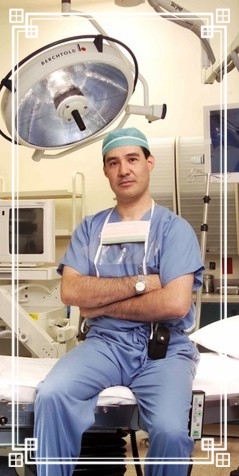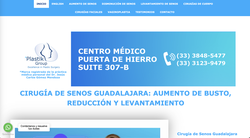Mastopexy

MASTOPEXY (Breast Lift)
Over the years, factors such as pregnancy, nursing, and the force of gravity take their toll on a woman’s breasts. As the skin loses its elasticity, the breasts often lose their shape and firmness and begin to sag. Breast lift, or Mastopexy, is a surgical procedure to raise and reshape sagging breasts, also can reduce the size of the areola, the darker skin surrounding the nipple. If your breasts are small or have lost volume (for example, after pregnancy) breast implants inserted in conjunction with mastopexy can increase both their firmness and their size.
If you’re considering a mastopexy, this information will help provide a basic understanding of what a breast lift can and cannot achieve. Because each individual patient is different no amount of written information can replace a personal consultation with Dr. Jesús Gómez Mendoza and his team.
The following information is strictly the opinion of Dr. Jesús Gómez Mendoza and pertains to breast lift procedures as performed by him.
Candidates for Mastopexy
The best candidates for mastopexy are healthy, emotionally-stable women who are realistic about what the surgery can accomplish. The best results are usually achieved in women with small, sagging breasts. Breasts of any size can be lifted, but the results may not last as long in very heavy breasts. Some techniques of mastopexy may leave noticeable, permanent scars, although they will be covered by your bra or bathing suit.
Planning your surgery
In your initial consultation, Dr. Jesús Gómez Mendoza and his team will evaluate your health and examine your breasts and measure them while you are sitting or standing, then we will discuss the variables that may affect the procedure ( such as your age, the size and shape of your breasts, and the condition of your skin ) and whether an implant is advisable. Explain which surgical techniques are most appropriate for you, based on the condition of your breast.
Preparing for your surgery
Depending on your age and family history, we may require you to have a mammogram (breast x-ray) before surgery. You will also get specific instructions on how to prepare for surgery, including guidelines on eating and drinking, smoking and taking or avoiding certain vitamins and medications.
Breast-lifts are usually done on an outpatient basis, but if you are admitted to the hospital as an inpatient, you can expect to stay one day.
If you smoke, plan to quit at least two weeks before your surgery and not to resume for at least two weeks after your surgery.
What type of anesthesia is used?
Dr. Jesús Gómez Mendoza performs most breast-lifts under sedation (gentle, short-acting medication administered by a board certified anesthesiologist to insure comfort and security for our patients) and local anesthesia. Patients are under monitored anesthesia care since they arrive to the operating room till they leave the recovery area. You will receive the safest care possible. The expert care you deserve.
Our patients recover more quickly and with less discomfort than when general anesthesia is used.
Where will your mastopexy be performed?
Dr. Jesús Gómez Mendoza performs most breast-lifts at the modern Puerta de Hierro Medical Center. Whether you choose to have your procedure done in the peaceful seclusion of our state-of-the-art Medical Center or at one of the many Guadalajara or Puerto Vallarta-area hospitals where we currently enjoy operating privileges; rest assured that you will receive the finest care available.
The surgery
Mastopexy usually takes one and a half to three and a half hours. Techniques vary, but the most common procedures are: 1) The doughnut (concentric or periareolar) breast-lift, in which circular incisions are made around the areola, and a doughnut-shaped area of skin is removed from the upper pole of the breast and 2) The anchor-shaped incision following the natural contour of the breast. The incision outlines the area the area from which breast skin will be removed and defines the new location for the nipple. When the excess skin has been removed, the nipple and areola are moved to the higher position. The skin surrounding the areola is then brought down and together to reshape the breast. Stitches are usually located around the areola, in a vertical line extending downwards from the nipple area, and along the lower crease of the breast. Finally, the incisions will be stitched (we only use absorbable sutures placed in an intradermal running fashion so you will not see them and they do not need to be removed). This technique obviates the need for external skin sutures and circumvents the possibility of suture marks.
Patients with relatively small breasts or moderate sagging may be candidates for modified procedures requiring less extensive incisions like the concentric mastopexy. If you are having an implant inserted along with your breast lift, it will be placed in a pocket directly under the breast tissue, or deeper, under the muscle of the chest wall (in some cases a breast implant is enough to produce the breast lift and avoid more scars).
After your surgery...
You’ll wear a support bra over your gauze dressings. Your breasts will be bruised, swollen and uncomfortable for a day or two, but the pain should be mild. Any discomfort you do feel can be relieved with your medications. You will wear the bra around the clock for four weeks.
If your breast skin is dry following surgery, you can apply a moisturizer several times a day. Be careful not to tug at your skin in the process, and keep the moisturizer away from the suture areas.
You can expect some loss of feeling in your nipples and breast skin, caused by the swelling. This numbness usually fades as the swelling subsides over the next two to six weeks.
Healing is a gradual process. Although you may be up and about in a day or two, do not plan on returning to work for a week. And avoid lifting anything over your head for three to four weeks.
You’ll be instructed to avoid sex for two weeks or more, and to avoid strenuous sports for about a month.
If you become pregnant, the operation will not affect your ability to breast-feed.
Your new look
We will make every effort to make your scars as inconspicuous as possible, it’s important to remember that mastopexy scars are permanent and your scars may actually appear to worsen during the first two to three months as they heal, but this is normal. Expect it to take six to nine months before your scars flatten out and lighten in color.
You should also keep in mind that a Mastopexy will not keep your breast firm forever (the effects of gravity, pregnancy, aging, and weight fluctuations will eventually take their toll again). Women who have implants along with their breastlift may find the results last longer.
Are there any risks?
When a mastopexy is performed by a qualified plastic surgeon certified by the Board of Plastic Surgery, complications are infrequent and usually minor.
While Dr. Jesús Gómez Mendoza and his team make every effort to minimize risk, individuals vary greatly in their anatomy, their healing ability as well as in their reactions to surgery and anesthesia. Complications that may occur include minor haematoma (a small collection of blood beneath the skin), infection, poor healing and reactions to medications. You can reduce your risks by closely following the advice of your surgeon concerning your pre-operative and post-operative care. There are not risk free surgical procedures.
To contact plastic surgeon Dr. Jesús Gómez Mendoza about any cosmetic surgery procedures, please fill out our contact form or call us at +52 (33) 3848-5477
Mastopexy or Breast Lift. Where outstanding outcomes are common. We are a Premier Plastic Surgery Practice in Guadalajara: breast surgery and more.
DR. JESÚS CARLOS GÓMEZ MENDOZA
Cirujano Plástico Estético y Reconstructivo UNAM
Ced. Prof. 1380418
Ced. Esp. 3223900
Certificado por CMCPER No. 682
Aviso de publicidad COFEPRIS 213301202A0627
CIRUGIA ESTETICA GUADALAJARA
Tel. (33) 3848-5477
Suite 307-B
Blvd. Puerta de Hierro # 5150
Zapopan, 45116
Horario:
Lunes a viernes
10:00am a 02:00pm
04:00pm a 08:00pm
Sábado
10:00am a 02:00pm
Especialista en Faloplastia, cirugía facial y corporal masculina

LINKS RÁPIDOS:
- Rinoplastia o Cirugia de Nariz
- Faloplastia
- Operacion de orejas o Cirugias de orejas
- Cirugia Estetica de Pantorrillas o implantes de pantorrillas
- Lipoescultura para hombres
- Cirugias Lipoescultura
- Levantamiento de senos
- Cirugia Plastica de Senos
- Lipoescultura laser costo
- Abdominoplastia o Lipectomía
- Liposuccion
- Implantes gluteos
- Lifting facial
- Blefaroplastia o Cirugia de Parpados
- Faloplastia precio
- Faloplastia antes y después















